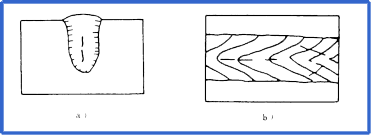- Testing
- Morphology Observation
- Microstructure Analysis
- Surface Element Analysis
- Surface Foreign Body
- Component Analysis
- Mechanical property test
- Thermal Analysis
- Welding Qualification
- CT Scan
- Nondestructive testing
- Cross Section Analysis
- Coating Thickness
- Flame Retardant Test
- Abration Test
- Coating quality inspection
Surface Crack Detection
| Visual Inspection | Nondestructive Inspection |
| Tensile Testing | Surface Crack Detection |
| Bend Test | Impact Test |
| Hardness Test | Low Times Metallographic Test |
Testing range:
Full penetration butt weld, T-joints, pipes, fillet weld and so on
The definition of surface crack:
The formation of new interface arising from the destruction of atom combination in crack leads to the gap production, which is called crack.
The classification of crack
According to the size of crack, crack can be divided into three categories: (1) macro-crack: can be visible to the naked eyes. (2) micro-cracks: can be found under the microscope. (3) can be found under the high multiple microscope, which generally refers to intercrystalline crack and intragranular crack.
The testing methods for surface crack:
1.Osmose process
Osmose process is a simple and effective nondestructive testing methods for work surface. It is mainly used for detecting meticulous defects on the surface of the work piece.
Fluorescence detection refers to put the work piece immerse in a kind of fluorescent liquid with strong adhesion and small surface tension, then remove from the work piece and wash the fluorescence liquid on the surface of work piece, and then spray the developer on the surface which can suck out the fluorescence liquid in the defect. After the above processing, place the work piece under the ultraviolet radiation, which will make the fluorescence liquid light in the defect, therefore, the defect can be found.
Coloring detection is a method using capillary, infiltration, adsorption phenomena in physics and developer to show the defect on the surface of work piece. It uses a kind of color penetrant (generally deep red) without fluorescent substance and the method is the same as fluorescence method. This method does not require ultraviolet light source, which can be carried out in a bright visible light.
2.Magnetic powder method
Magnetic powder refers to apply a magnetic field on the tested work piece to make the work piece magnetization. The surface of the work piece or the near-surface defects will escape magnetic force lines forming leakage magnetic field. The presence of additional poles can absorb the surface of the magnetic powder forming aggregated magnetic marks, thus showing the presence of defects.

- Learn more
- Qualification and honor
- Contact Us
- Contact Us
MTT Shenzhen
Tel: 400-850-4050
Fax: 0755-2782 1672
Email: marketing@mttlab.com
MTT Suzhou
Tel: 400-118-1002
Fax: 0512-6275 9537
Email: marketing@mttlab.com
MTT Shanghai
Tel: 400-118-1002
Email: marketing@mttlab.com
MTT Dongguan
Tel: 400-116-1002
Email:marketing@mttlab.com
